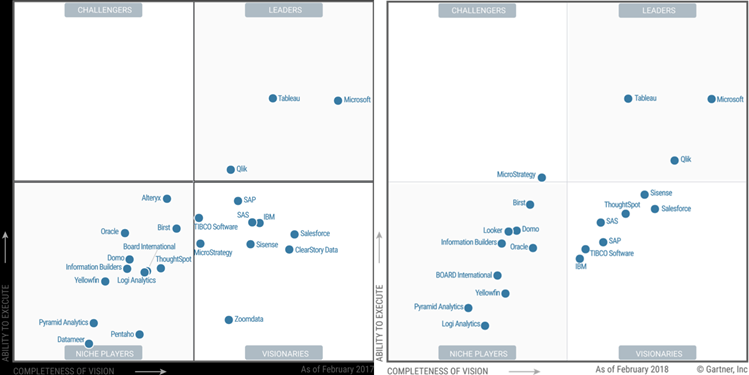2018 Gartner Magic Quadrant for Analytics and BI Platforms
The 2018 Gartner Magic Quadrant for Analytics and Business Intelligence Platforms is out. I read the report and followed the dots. I personally hoped to see the Microsoft dot higher than the overrated Tableau, given everything I said here, here, and here. I’m glad that Gartner finally realized what I have been saying all along that Tableau lacks “complex data model support” among many other things.
Anyway, this is a great endorsement of how far Power BI has come. And about what Microsoft can do when product groups work together. Mind you, the main focus of the Gartner’s evaluation was Power BI. The organizational BI pieces (SQL Server, SSRS, SSAS, SSIS, Azure) were not considered.
Here are my thoughts about the Microsoft-related cautions cited by Gartner:
- Mode 2 analytics, Azure cloud only – “Power BI has mainly focused on the requirements for Mode 2 (agile, self-service) analytics, while its on-premises SQL Server Reporting Services serves the needs of Mode 1 (for scheduled, distributed reports). For Microsoft customers, this has resulted in a two-product deployment with different capabilities and different deployment approaches. Microsoft’s reference customers cited absent or weak functionality (14%) as a limitation to wider deployment, with 27% (the highest percentage of respondents for this Magic Quadrant) citing a range of other problems.” Gartner has a point here. “Cloud first” shouldn’t mean “on premises never”. Supporting Power BI reports in Power BI Report Server (an add-on to SSRS) was a great move but customers expect to get at least the most important Power BI features, such as dashboards, Q&A, online report editing, Quick Insights, embedded APIs. But they are not in Power BI Report Server and there is no roadmap when they will arrive on premises if ever. If there is a fear that Power BI Report Server would cannibalize the cloud, then maybe we shouldn’t have Power BI Report Server at all. The interesting part is that some on-premises features, such as Excel workbooks with live connections, are not supported in the cloud. So, the feature mismatch goes both ways. I hope Microsoft addresses this as it’s a biggy for my clients.
- Breadth of use – “As previously, Microsoft’s scores from its reference clients place it in the bottom quartile for breadth of use. Breadth of use looks at the percentage of users using the product for a range of BI styles: from viewing reports, creating personalized dashboards and doing simple ad hoc analysis, to performing complex queries, data preparation and using predictive models“. Not sure I agree with this one. My observations do show that business users don’t bother to learn the more advanced features, such as Power Query. But whose problem is this? Further “This pattern of use suggests that the more advanced data preparation is performed outside Power BI“, there are absolutely cases that go beyond a typical power user and such tasks are better done by IT, such as data integration in a central data repository. Do Tableau and Qlik handle advanced data preparation? Wait, Tableau doesn’t even have data integration while Qlik requires scripting.
- Multiple products – “The core of Microsoft Power BI is a self-contained product. However, a number of elements in Microsoft’s roadmap that are part of the product vision span multiple products and require integration. For example, insight to action requires Microsoft Flow.” I don’t see a problem with having multiple products if they can integrate. Especially given that some are free, such as PowerApps and Flow with O365. The reason why they are separate products is that they don’t apply to BI only. And which BI vendor has flow, business apps, predictive models, in the same product? Not to mention that Tableau and Qlik don’t have anything more than just a reporting tool.
- Sales experience – “The majority of Microsoft’s reference customers evaluated their sales experience as good to excellent. However, in relative terms, Microsoft is slightly below average for this Magic Quadrant.” I haven’t gotten feedback from clients about their sales experience, so I can’t comment but I thought Gartner should have elaborated more on this and beyond “relative terms”. Further, “While Microsoft Power BI is a low-priced option, clients expressed frustration about changes in the pricing and packaging and the lack of clarity about what Power BI functionality is included with Microsoft Dynamics 365.” So, Power BI pricing has remained the same and it’s clearly stated. I think what Gartner meant is that the Power BI Embedded pricing story has changed. I wonder how many customers complained about the Dynamics 365 integration.





